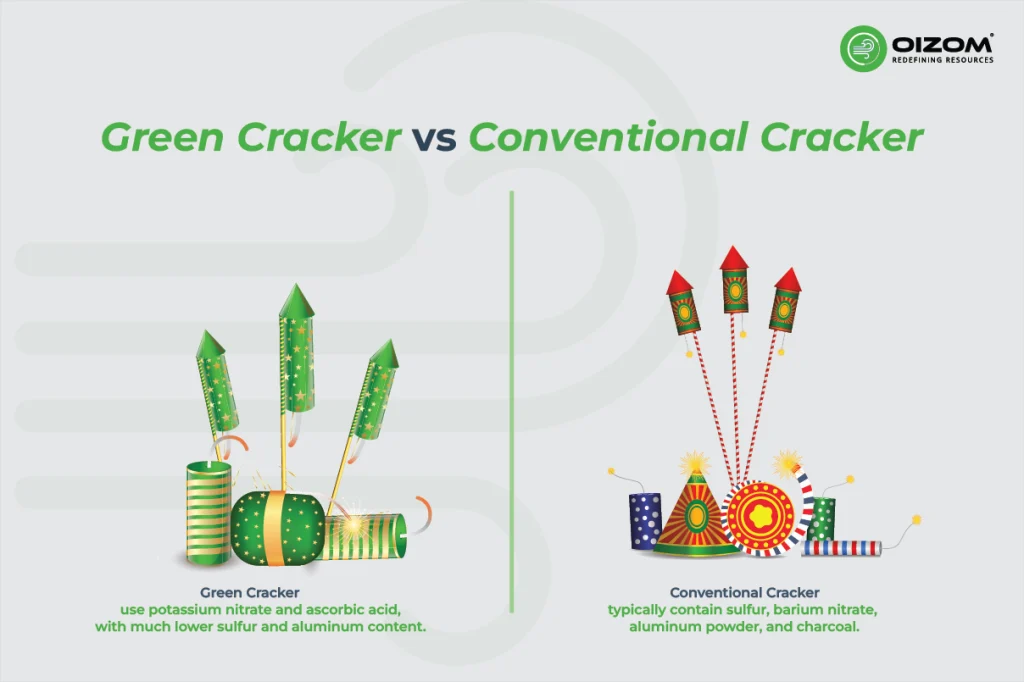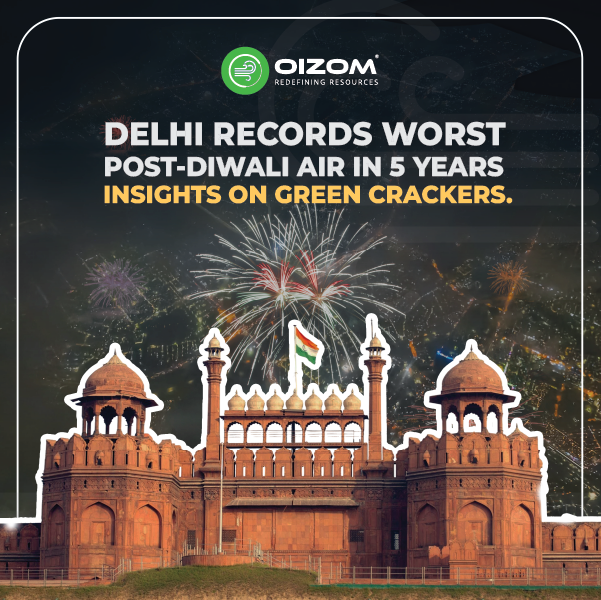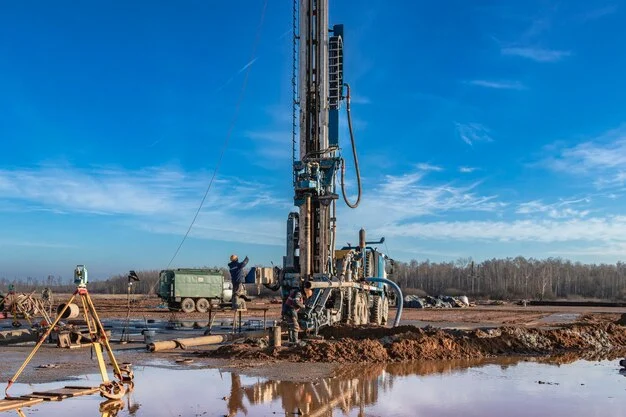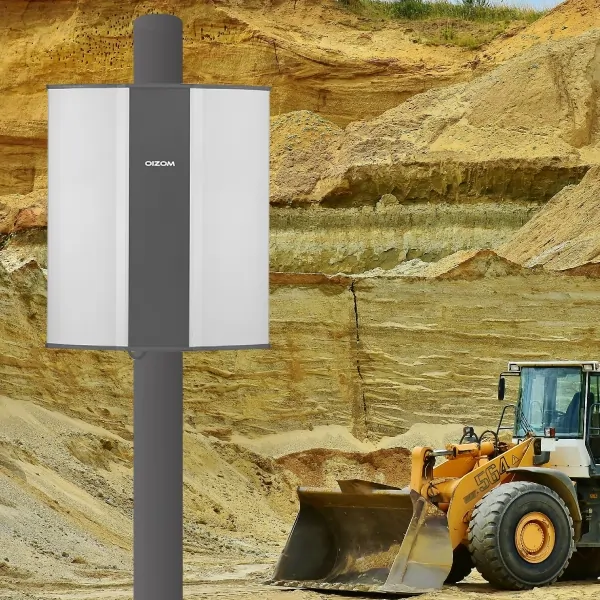Summary
- Delhi’s air post-Diwali 2025 recorded its worst level in 5 years, with AQI reaching 470 and PM₂.₅ peaking at 600 µg/m³.
- Green crackers, introduced to cut emissions by 25–30%, proved ineffective in curbing the pollution rise due to widespread use, weather stagnation, and stubble smoke.
- Mislabeling and poor enforcement may have led to many “green” fireworks being uncertified.
- Data revealed rapid overnight surges in PM₂.₅ and NO₂, emphasizing the need for data-driven alerts.
- For residents, AQI tracking, N95 masks, and purifiers remain vital protection during smog spikes.
- The takeaway: Technology helps, but proactive measures, awareness, and continuous monitoring are more important.
Delhi Records Worst Post-Diwali Air in 5 Years: Insights on Green Crackers
The morning after Diwali 2025, Delhi woke up to a blanket of smog that blurred the city lights even after the festivities had ended. By morning, air quality monitors across the capital showed alarming levels, with multiple stations crossing the “severe” threshold. The city’s average AQI soared above 680 in certain zones, the worst post-Diwali air in the past five years, in spite of the widespread use of green crackers.
For locals, it posed the same question: if these eco-friendly firecrackers were designed to emit less, why did the air still choke with PM2.5, SO₂, and NOx? The answer lies in a complex interaction of weather, chemistry, and urban density, along with how to monitor and address these invisible pollutants.
How Severe Was Delhi’s Air Quality Post-Diwali 2025?
In the week before Diwali 2025, Delhi’s air quality varied between the “Moderate” and “Poor” categories, with the average AQI hovering around 180–230. Despite warnings from the IMD and pollution authorities, the combination of the firecrackers, stagnant air, and increasing humidity quickly spiraled the air quality into crisis conditions.
The morning after Diwali, Delhi woke to an AQI of over 470, firmly placing it in the “Severe” category, which was the worst post-Diwali air quality over the last five years. The city’s skyline disappeared into the heavy grey haze, visibility dropped sharply, and pollutants hung in the air for hours. Real-time detections at monitoring stations in Anand Vihar, Jahangirpuri, and RK Puram revealed PM2.5 readings exceeding 600 µg/m³, nearly ten times the national health-based standards.
In comparison, post-Diwali 2024 saw an AQI peak of around 410, while post-Diwali 2023 air quality touched 390; though both levels are severe, there’s a marked difference between the air quality in Delhi in 2025 and the previous two years. Experts explained that the intention of “green crackers” was to improve post-Diwali emissions by around 30%. However, the overall volume of bursting, combined with poor meteorological conditions and residual smoke from crop burning in neighboring states, effectively eliminated the observed gains.
What Are Green Crackers and Their Intended Purpose?

When the air in India’s cities began turning toxic after Diwali, scientists at CSIR-NEERI set out to reinvent the firecracker. The goal was simple: preserve the festive sparkle while curbing the smoky aftermath. Thus, the idea of “green crackers” was born.
Unlike conventional firecrackers, which rely on high-sulphur and nitrate compounds to produce dazzling colors and loud effects, green crackers use alternative oxidizers and reduced chemical loads. In place of barium nitrate, a notorious pollutant banned due to its health hazards, they incorporate potassium nitrate and ascorbic acid, or other mild oxidants that release less sulfur dioxide (SO₂), nitrogen oxides (NOx), and particulate matter (PM) when burned.
The science behind the “green” lies in controlling combustion chemistry. By lowering the reaction temperature and adjusting the metal salt content, these crackers reduce the amount of fine particles and toxic gases released into the air. According to CSIR-NEERI and the Petroleum and Explosives Safety Organization (PESO), green crackers can reduce emissions by 25–30% compared to traditional ones. Some variants even include dust-suppressing additives that trap residual pollutants in the plume before they disperse.
These innovations were never meant to dim the spirit of Diwali, but to make celebrations more sustainable. Essentially, green crackers represent a scientific middle ground between celebration and sustainability. Yet, as Delhi’s 2025 post-Diwali air revealed, their expected benefits don’t always work smoothly on the ground.
Why Did Green Crackers Fail to Improve Post-Diwali Air Quality?
Even though they were supposed to help, green crackers alone could not prevent Delhi’s post-Diwali (2025) air from becoming toxic. The issue isn’t just rooted in one cause: it’s the result of intersecting environmental, behavioral, and logistical factors.
To make things even more complicated, many of the “green” crackers that people bought were not even legitimately certified. Weak enforcement and mislabeling meant that regular fireworks were packaged to appear eco-friendly. Further complicating the situation was the weather, with low wind speeds and high humidity, which trapped pollutants close to the ground. The crop burning and debris buildup on the ground also exacerbated the haze.
Experts also point out that awareness among the general public regarding the actual PESO-certified “green” crackers is very low. The effectiveness of any measure will be compromised without monitoring and education.
Overall, Delhi was not facing an air crisis due to the type of crackers people used. It was about how the pollution accumulated and lingered. This is also why we must rely on real-time air quality monitoring to see what is actually effective or not in these challenging environmental contexts.
Role of Air Quality Monitoring in Tracking Post-Diwali Pollution
Air quality monitoring is an important part of assessing the speed and severity of pollutant escalation during and after celebrations. Continuous monitoring networks, such as CPCB, SAFAR, and smart sensor systems by Oizom, can capture hourly changes in PM2.5, PM10, SO₂, and NO₂ levels, indicating how quickly the city’s air quality worsens overnight.
During Diwali 2025, PM2.5 levels in Delhi increased in multiple areas from approximately 120 µg/m³ to about 600 µg/m³ in a matter of a few hours, and NO₂ concentrations doubled due to nitrate-based cracker combustion. It is challenging for authorities to issue timely warnings to the public and enforce emergency measures (e.g., school closures, traffic restrictions) without detailed air quality information on rapid and significant changes.
What makes real-time monitoring relevant goes beyond identifying the problem. It can be effective at measuring the feedback of interventions like green crackers or bans on fireworks. Systems such as Oizom’s Polludrone provide hyperlocal data that visualize the buildup of pollution in relation to specific locations, helping to assess whether policies intended to reduce emissions are having an effect.
How Air Quality Monitoring Can Help Prevent Future Crises
Air quality monitoring is not just about understanding what has gone wrong; it is about helping to predict what might go wrong. By reviewing continuous data, cities can identify pollution trends prior to significant pollution events, allowing cities to impose restrictions, adjust traffic volume, and curtail firecrackers, for example, before pollution escalates.
In the absence of real-time AQI information, residents would still be able to use their knowledge of air quality updates to make informed choices, such as when to be outdoors and how to use purifiers in their homes. Furthermore, as seen in post-Diwali 2025, monitoring data can help identify pollution hotspots and periods for which monitoring and restrictions would be most appropriate in 2026.
Monitoring transforms air data into foresight, allowing for proactive action, moving from a reactionary response to a proactive one after Diwali in Delhi.
Practical Tips for Residents During Post-Diwali Pollution Spikes

When the post-Diwali air gets heavy, there are small things that can be of help.
- First, keep the windows shut when the smog is at its peak (generally early in the morning and late at night) and use air purifiers and indoor plants, which can help limit particulate buildup.
- When going outside, wear a fitted N95 mask and avoid heavy outdoor activities that are exhausting, such as running or other strenuous exercises.
- Water and nutrition also play a role; eating food rich in vitamin C and antioxidants can help your body cope with poor air quality.
- The air quality index (AQI) is a good way to determine when you may want to do your errands outside, as the levels of particulate matter vary slightly throughout the day.
While these actions may only take a few days to practice, they build awareness and resilience for cleaner celebrations ahead.
Conclusion
Delhi in 2025, after Diwali, reveals a harsh truth: that a technological fix alone cannot remedy a problem as complex as urban air pollution. Green crackers were a good step, but without proper monitoring, enforcement, and weather awareness, even clean fireworks can create severe smog when used excessively. Implementing real-time air pollution monitoring, such as Oizom’s sensor-based systems, could enable cities to predict and curtail these pollution peaks before they become hazardous. As Delhi looks ahead to future festive seasons, the goal isn’t to dim the sparkle of Diwali, but to ensure the air that follows remains clear enough to see it.
FAQs:
Green crackers are modified firecrackers developed by CSIR-NEERI that emit about 30% less particulate matter and harmful gases compared to conventional ones. However, they were unable to offset Delhi’s extreme post-Diwali pollution in 2025 due to scale and weather conditions.
Residents can limit outdoor activity, use air purifiers indoors, wear N95 masks, and track real-time AQI updates to plan safer routines after Diwali.
Weather factors like low wind speed, temperature inversion, and high humidity trap pollutants near the ground, reducing the dispersal effectiveness of green crackers.






